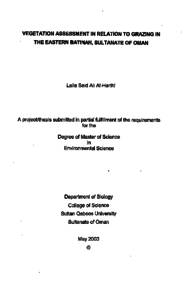وثيقة
Vegetation assessment in relation to grazing in the Eastern Batinah, Sultanate of Oman
الناشر
Sultan Qaboos University
ميلادي
2003
اللغة
الأنجليزية
الموضوع
الملخص الإنجليزي
The impacts of grazing animals on the vegetation of arid lands is frequently severe and a major contributor to land degradation. In Oman, this problem has received considerable attention in the southern province of Dhofar, but relatively little research or concern has focused on the northern Batinah region. This project is the first to quantify the vegetation of the Batinah and the degree to which its plant resources have been affected by livestock. The aims of this research are to: 1) identify the perennial plants and quantify their coverage and frequency; 2) evaluate the degree of utilization of the perennial vegetation by livestock; 3) assess the impact of grazing by comparing characteristics of the vegetation in a site protected from grazing with those of adjacent non-protected sites; 4) attempt to use Landsat images to quantify changes that have occurred in the plant coverage from 1985 to 2000.
The research area (250 km) was divided into 10 blocks of 5 x5 km. Two sites were randomly selected in each block for the vegetation analysis. Line transects (800 m long) were used to estimate coverage and frequency at each site. Grazing intensity was approximated by an ordinal scale. The same procedures were used at 4 sites inside a 1 X 4 km site protected from grazing for the past 10 years.
Three vegetation types are common in the eastern Batinah. A shrubland community occurs on wide shallow wadis with finer alluvial soils; Acacia tortilis woodlands characterize higher plains with small surface gravels; and, a wadi community of mixed trees and shrubs occurs along deeper channels that dissect the gravel plains and have various sized rocks and gravels. Vegetation coverage by perennials ranged from 0.9 to 8% on the 21 non-protected sites. Eighteen of these sites were classified as lightly grazed and 3 were moderately grazed. Many plants (64 %) on the lightly grazed sites are species with defensive spines, thorns or noxious chemicals and are considered undesirable fodder. Coverage in the protected sites ranged from 2 to 5.6%. Species that are frequently foraged (e.g., Farsetia aegyptiaca Panicum turgidum, Crotalaria aegyptiaca, Heliotropium europaeum) were significantly larger in the protected site. One grass (Dichanthium cf. faveolatum) was found only in the protected site, and plant litter was much more abundant.
The results confirm several trends previously reported from arid rangelands. Overstocking has reduced coverage by palatable species while increasing coverage and frequency of perennial plants with defensive mechanisms against herbivores. Although the total vegetative cover did not increase after 10 years of protection, the dominant forage species were significantly larger and their frequency has become more compared to plants on grazed rangeland.
المجموعة
URL المصدر
الملخص العربي
يعتبر الرعي الجائر من الأسباب الرئيسة التي تؤدي إلى تدهور الأراضي في المناطق الجافة و شبه الجافة. حيث تعد محافظة ظفار في سلطنة عمان من أكثر المناطق تاثرا بالرعي الجائر في السلطنة. وقد أجريت العديد من البحوث و الدراسات حول هذه المشكلة في المنطقة، بينما حظيت بقية المناطق و منها منطقة الباطنة بالقليل من الدراسات تعتبر هذه الدراسة هي الأولى من نوعها في منطقة الباطنة، و تهدف إلى: 1) التعرف على النباتات الحولية الموجودة بالمنطقة و قياس الغطاء النباتي ومدی توزعه. 2) تقييم مدى استهلاك الحيوانات لهذه النباتات. 3) تقييم مدى تأثر النباتات بالرعي عن طريق المقارنة بين منطقة محمية من الرعي و أخرى غير محمية. 4) استخدام الصور الجوية للتعرف على التغير الذي حدث في الغطاء النباتي من عام 1985 إلى عام 2000م. بلغت مساحة منطقة الدراسة في شرق الباطنة 250كم2، تم تقسيمها إلى 10 مناطق متساوية بلغت مساحة كل منها 25كم . في كل منطقة تم اختيار موقعين بشكل عشوائي لدراسة النباتات و تقييم مدى تأثرها بالرعي، كما تمت دراسة 4 مواقع في المنطقة المحمية من الرعي ( محمية من حوالي 10 سنوات) والتي تبلغ مساحتها 4كم2 تتقسم منطقة الدراسة إلى ثلاثة مجتمعات نباتية هي: مجتمع الشجيرات و الذي يتواجد في الأودية العريضة الغير عميقة و التربة الطميية ، مجتمعات الأودية ، و تتكون النباتات فيها من الشجيرات و الأشجار معا، ومجتمعات الغابات الشجرية و تتواجد على اراضي مرتفعة ، و تعتبر أشجار السمر(Acacia tortilis ) هي الأشجار السائدة في هذه الغابات. تراوح الغطاء النباتي بين 0. 9 % إلى 8 . 0 % في المواقع الغير محمية من الرعي (21 موقعا). تم تصنيف ثمانية عشر من هذه المواقع متاثرة بدرجة بسيطة بالرعي و ثلاثة مواقع متوسطة التأثر. تعتبر العديد من النباتات ( % 64) المتواجدة في الثمانية عشر موقع من أنواع النباتات التي تملك أساليب دفاعية ضد الرعي كالأشواك و المواد السامة و بالتالي تمثل غذاء غير مرغوب به من قبل الحيوانات. بينما تراوح الغطاء النباتي في المنطقة المحمية بين 2. 0 - 5 . 6 %. أنواع النباتات التي من الشائع أنها ترعى من قبل الحيوانات مثل: Heliotropium europaeum , Farsetia aegyptiaca , Crotalaria aegyptiaca كانت أكبر و أطول في المنطقة المحمية مقارنة بنفس النباتات في المناطق غير المحمية. تم التعرف على نوع من الحشائش متواجد فقط في المنطقة المحمية و لم يوجد في المنطقة غير المحمية و هو Dichanthium of faveolatum. كما أن الغطاء المتواجد تحت الأشجار - و المتكون من الأوراق المتساقطة الجافة و البنور- متواجد بكثرة في المنطقة المحمية. اثبتت نتائج هذه الدراسة العديد من الحقائق التي تم تسجيلها سابقا" من الأراضي الرعوية في المناطق الجافة. واهمها هي أن تحميل المرعى فوق طاقته من الحيوانات يؤدي إلى انخفاض النباتات المستساغة و ازدياد النباتات الغير مستساغة. و على الرغم من أن الغطاء النباتي لم يتغير بعد حوالي عشر سنوات من الحماية، إلا أن النباتات المستساغة كانت أكبر حجما.
قالب العنصر
الرسائل والأطروحات الجامعية

